An Analysis of IFRS 16: New Accounting Standards for Lease Contracts
VerifiedAdded on 2022/11/16
|11
|2195
|308
Report
AI Summary
This report provides a detailed analysis of IFRS 16, the new accounting standard for lease contracts, which replaced IAS 17. It examines the key alterations introduced by IFRS 16, focusing on the recognition of leased assets and liabilities on the balance sheet, impacting metrics like EBITDA, leverage ratios, and return on invested capital. The report evaluates the drawbacks of previous accounting standards and highlights the advantages of IFRS 16, such as improved comparability and transparency. It further explores the impacts of these changes on companies significantly involved in lease financing, addressing topics like operating leases, positive accounting theory, and managerial attitudes towards lease contracts. The report also summarizes the main disclosures required by companies regarding transitional provisions and the overall impact of the new standard, providing a comprehensive overview of the shift in accounting practices. The report also contains references to the existing literature on the subject matter.
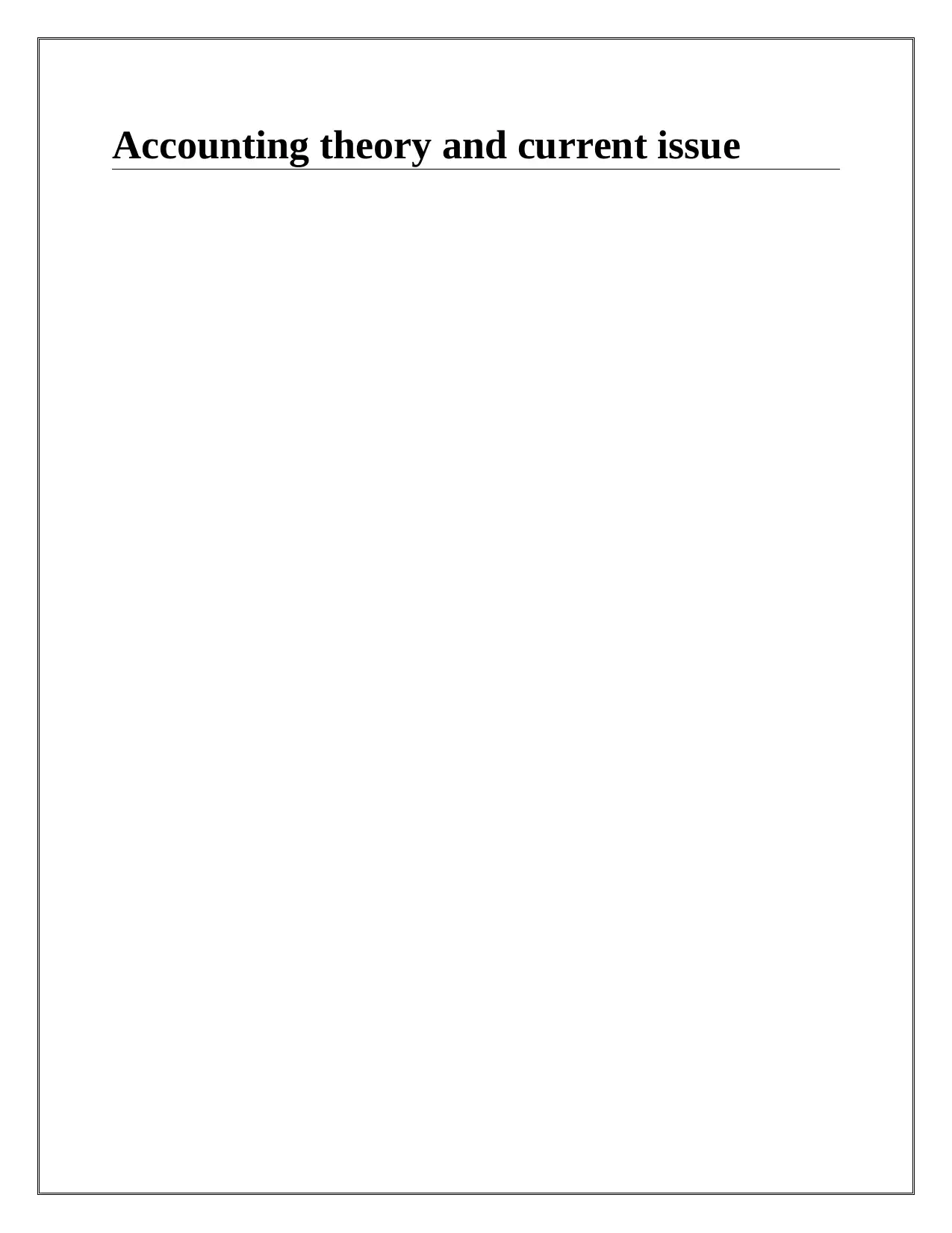
Accounting theory and current issue
Paraphrase This Document
Need a fresh take? Get an instant paraphrase of this document with our AI Paraphraser
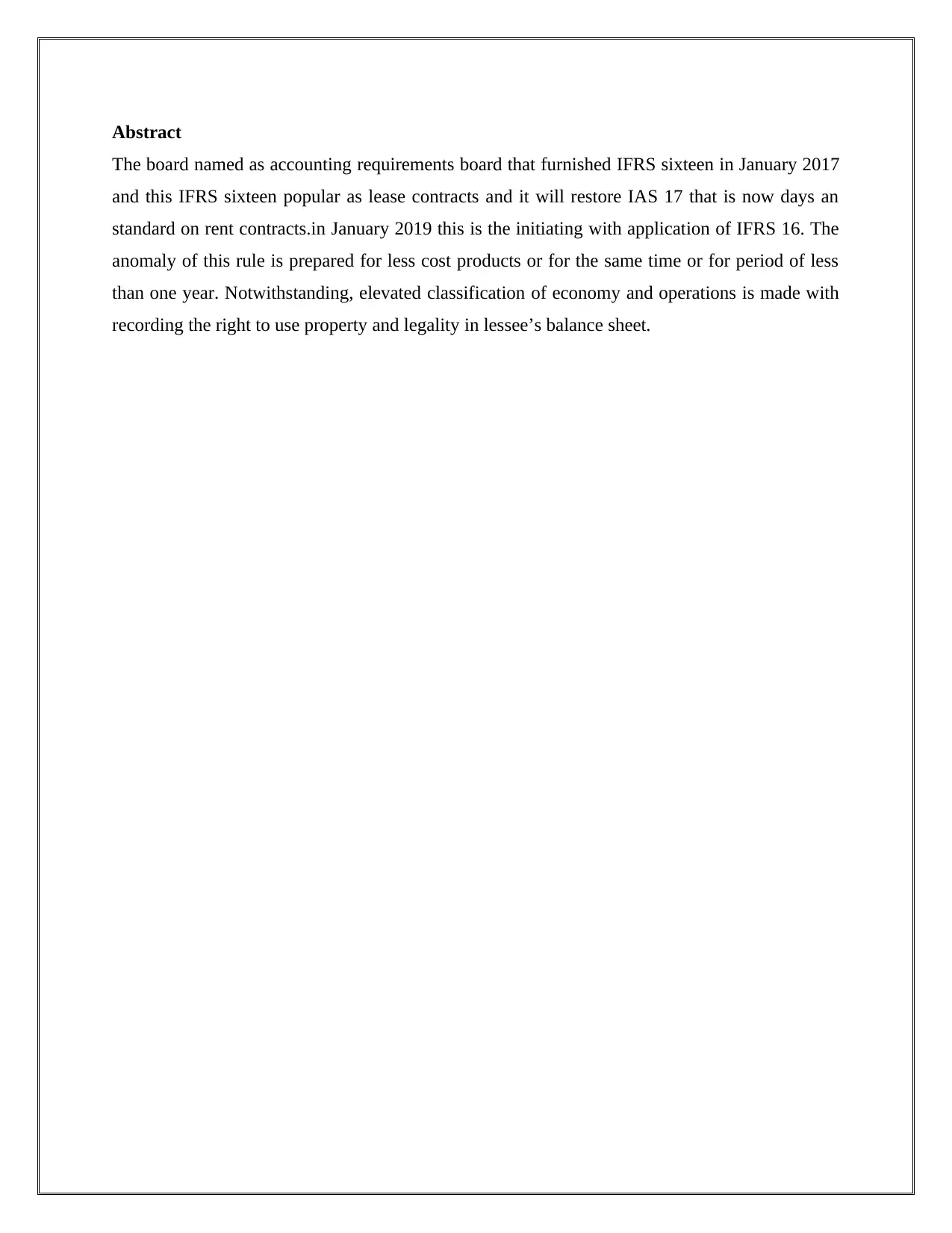
Abstract
The board named as accounting requirements board that furnished IFRS sixteen in January 2017
and this IFRS sixteen popular as lease contracts and it will restore IAS 17 that is now days an
standard on rent contracts.in January 2019 this is the initiating with application of IFRS 16. The
anomaly of this rule is prepared for less cost products or for the same time or for period of less
than one year. Notwithstanding, elevated classification of economy and operations is made with
recording the right to use property and legality in lessee’s balance sheet.
The board named as accounting requirements board that furnished IFRS sixteen in January 2017
and this IFRS sixteen popular as lease contracts and it will restore IAS 17 that is now days an
standard on rent contracts.in January 2019 this is the initiating with application of IFRS 16. The
anomaly of this rule is prepared for less cost products or for the same time or for period of less
than one year. Notwithstanding, elevated classification of economy and operations is made with
recording the right to use property and legality in lessee’s balance sheet.
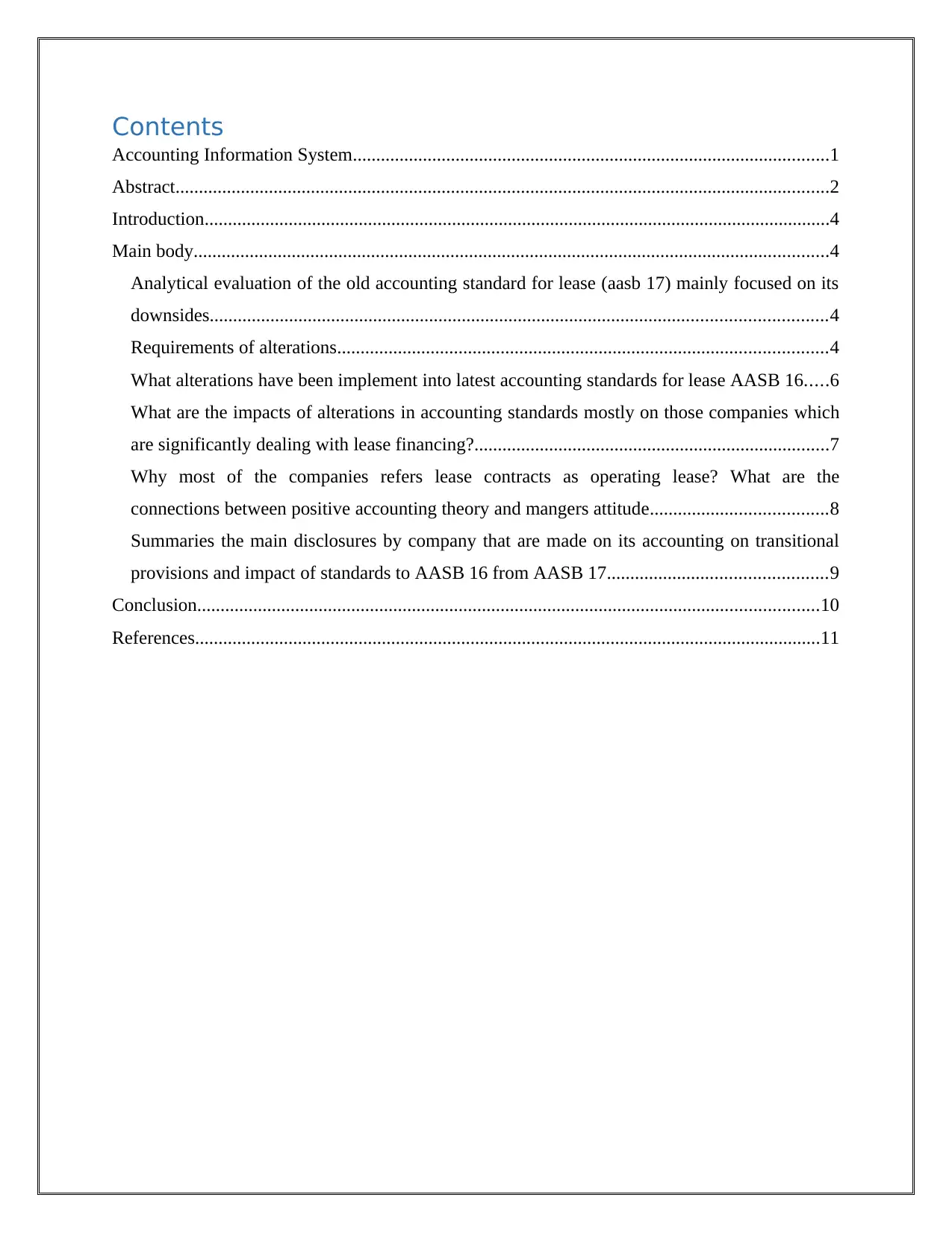
Contents
Accounting Information System......................................................................................................1
Abstract............................................................................................................................................2
Introduction......................................................................................................................................4
Main body........................................................................................................................................4
Analytical evaluation of the old accounting standard for lease (aasb 17) mainly focused on its
downsides....................................................................................................................................4
Requirements of alterations.........................................................................................................4
What alterations have been implement into latest accounting standards for lease AASB 16.....6
What are the impacts of alterations in accounting standards mostly on those companies which
are significantly dealing with lease financing?............................................................................7
Why most of the companies refers lease contracts as operating lease? What are the
connections between positive accounting theory and mangers attitude......................................8
Summaries the main disclosures by company that are made on its accounting on transitional
provisions and impact of standards to AASB 16 from AASB 17...............................................9
Conclusion.....................................................................................................................................10
References......................................................................................................................................11
Accounting Information System......................................................................................................1
Abstract............................................................................................................................................2
Introduction......................................................................................................................................4
Main body........................................................................................................................................4
Analytical evaluation of the old accounting standard for lease (aasb 17) mainly focused on its
downsides....................................................................................................................................4
Requirements of alterations.........................................................................................................4
What alterations have been implement into latest accounting standards for lease AASB 16.....6
What are the impacts of alterations in accounting standards mostly on those companies which
are significantly dealing with lease financing?............................................................................7
Why most of the companies refers lease contracts as operating lease? What are the
connections between positive accounting theory and mangers attitude......................................8
Summaries the main disclosures by company that are made on its accounting on transitional
provisions and impact of standards to AASB 16 from AASB 17...............................................9
Conclusion.....................................................................................................................................10
References......................................................................................................................................11
⊘ This is a preview!⊘
Do you want full access?
Subscribe today to unlock all pages.

Trusted by 1+ million students worldwide
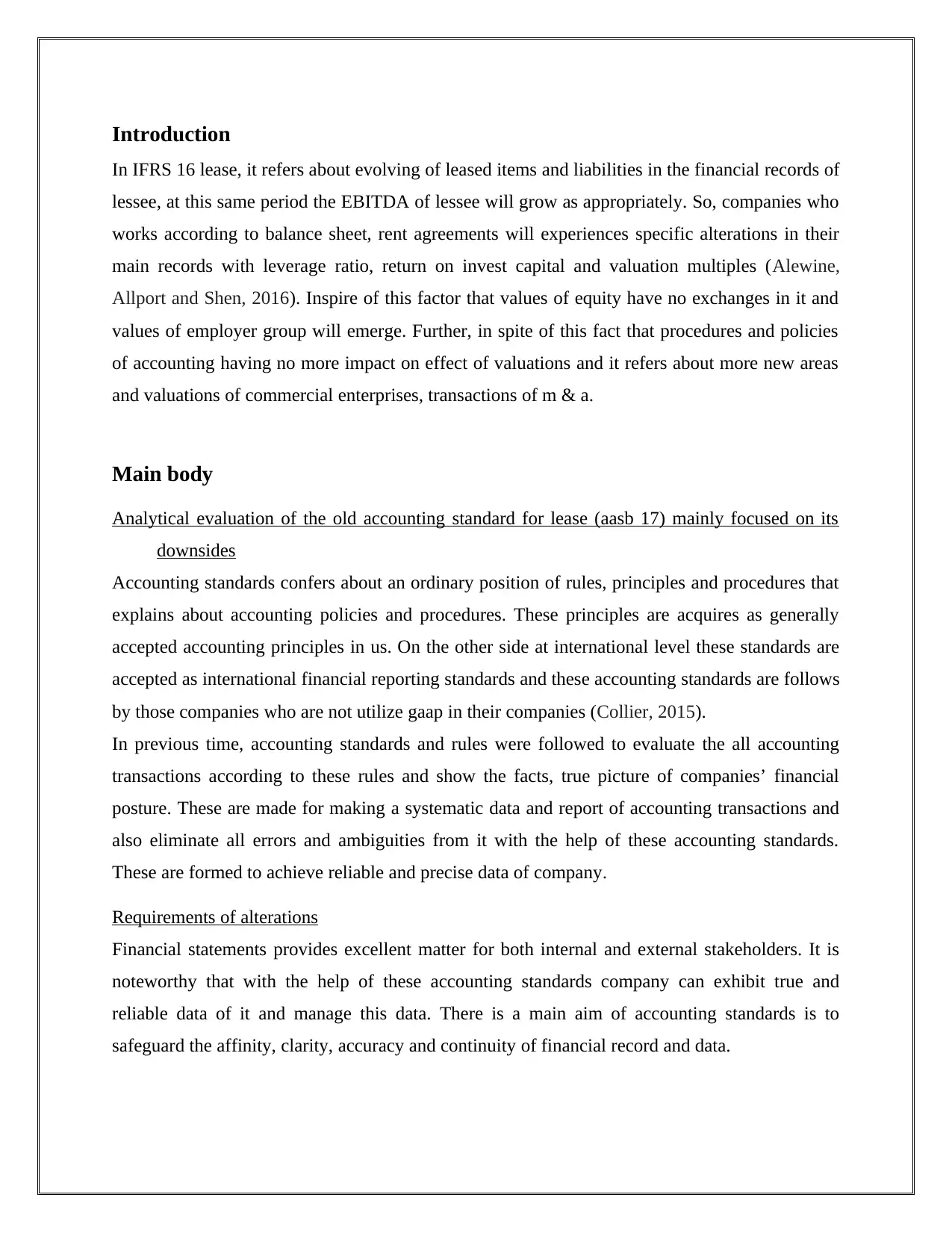
Introduction
In IFRS 16 lease, it refers about evolving of leased items and liabilities in the financial records of
lessee, at this same period the EBITDA of lessee will grow as appropriately. So, companies who
works according to balance sheet, rent agreements will experiences specific alterations in their
main records with leverage ratio, return on invest capital and valuation multiples (Alewine,
Allport and Shen, 2016). Inspire of this factor that values of equity have no exchanges in it and
values of employer group will emerge. Further, in spite of this fact that procedures and policies
of accounting having no more impact on effect of valuations and it refers about more new areas
and valuations of commercial enterprises, transactions of m & a.
Main body
Analytical evaluation of the old accounting standard for lease (aasb 17) mainly focused on its
downsides
Accounting standards confers about an ordinary position of rules, principles and procedures that
explains about accounting policies and procedures. These principles are acquires as generally
accepted accounting principles in us. On the other side at international level these standards are
accepted as international financial reporting standards and these accounting standards are follows
by those companies who are not utilize gaap in their companies (Collier, 2015).
In previous time, accounting standards and rules were followed to evaluate the all accounting
transactions according to these rules and show the facts, true picture of companies’ financial
posture. These are made for making a systematic data and report of accounting transactions and
also eliminate all errors and ambiguities from it with the help of these accounting standards.
These are formed to achieve reliable and precise data of company.
Requirements of alterations
Financial statements provides excellent matter for both internal and external stakeholders. It is
noteworthy that with the help of these accounting standards company can exhibit true and
reliable data of it and manage this data. There is a main aim of accounting standards is to
safeguard the affinity, clarity, accuracy and continuity of financial record and data.
In IFRS 16 lease, it refers about evolving of leased items and liabilities in the financial records of
lessee, at this same period the EBITDA of lessee will grow as appropriately. So, companies who
works according to balance sheet, rent agreements will experiences specific alterations in their
main records with leverage ratio, return on invest capital and valuation multiples (Alewine,
Allport and Shen, 2016). Inspire of this factor that values of equity have no exchanges in it and
values of employer group will emerge. Further, in spite of this fact that procedures and policies
of accounting having no more impact on effect of valuations and it refers about more new areas
and valuations of commercial enterprises, transactions of m & a.
Main body
Analytical evaluation of the old accounting standard for lease (aasb 17) mainly focused on its
downsides
Accounting standards confers about an ordinary position of rules, principles and procedures that
explains about accounting policies and procedures. These principles are acquires as generally
accepted accounting principles in us. On the other side at international level these standards are
accepted as international financial reporting standards and these accounting standards are follows
by those companies who are not utilize gaap in their companies (Collier, 2015).
In previous time, accounting standards and rules were followed to evaluate the all accounting
transactions according to these rules and show the facts, true picture of companies’ financial
posture. These are made for making a systematic data and report of accounting transactions and
also eliminate all errors and ambiguities from it with the help of these accounting standards.
These are formed to achieve reliable and precise data of company.
Requirements of alterations
Financial statements provides excellent matter for both internal and external stakeholders. It is
noteworthy that with the help of these accounting standards company can exhibit true and
reliable data of it and manage this data. There is a main aim of accounting standards is to
safeguard the affinity, clarity, accuracy and continuity of financial record and data.
Paraphrase This Document
Need a fresh take? Get an instant paraphrase of this document with our AI Paraphraser
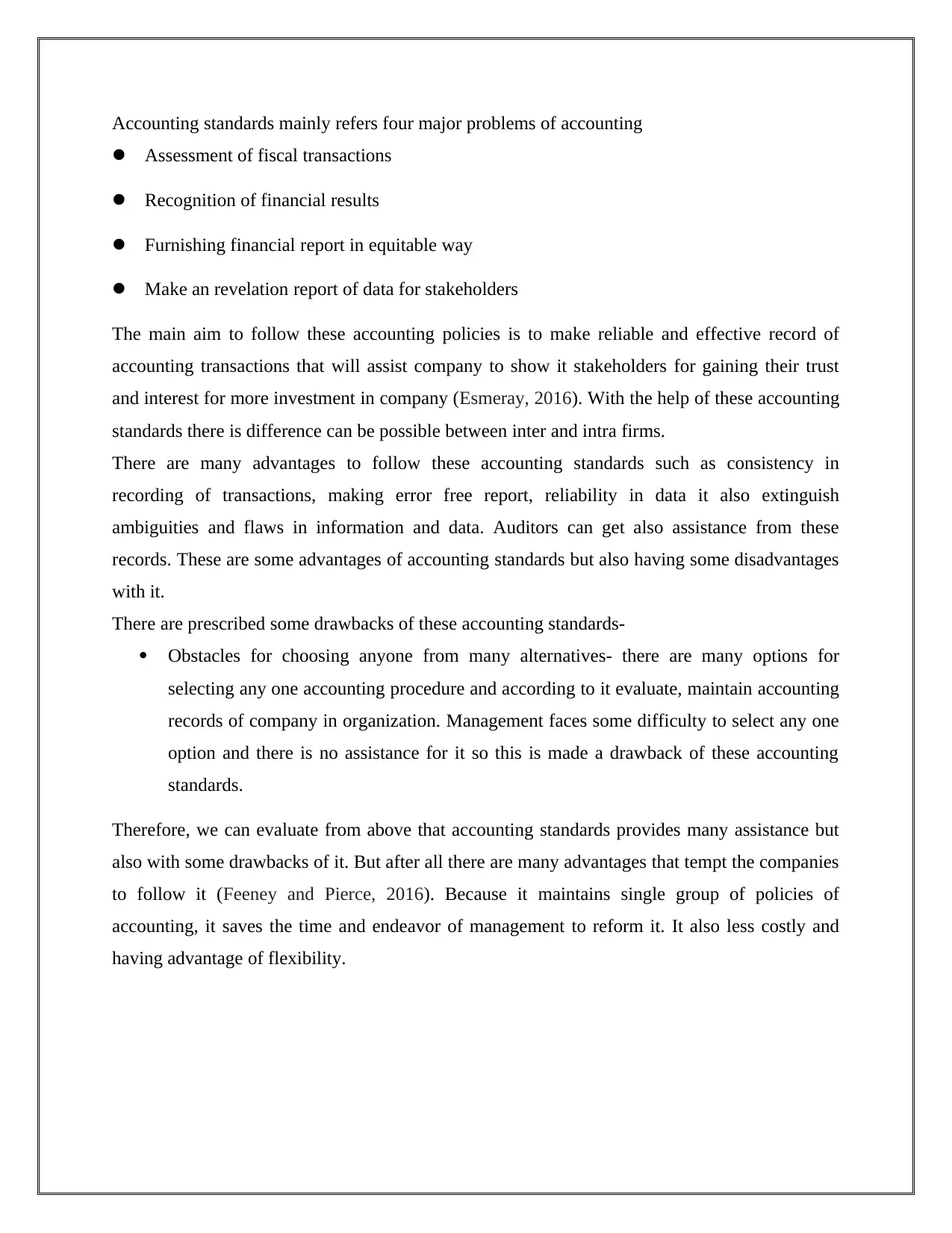
Accounting standards mainly refers four major problems of accounting
Assessment of fiscal transactions
Recognition of financial results
Furnishing financial report in equitable way
Make an revelation report of data for stakeholders
The main aim to follow these accounting policies is to make reliable and effective record of
accounting transactions that will assist company to show it stakeholders for gaining their trust
and interest for more investment in company (Esmeray, 2016). With the help of these accounting
standards there is difference can be possible between inter and intra firms.
There are many advantages to follow these accounting standards such as consistency in
recording of transactions, making error free report, reliability in data it also extinguish
ambiguities and flaws in information and data. Auditors can get also assistance from these
records. These are some advantages of accounting standards but also having some disadvantages
with it.
There are prescribed some drawbacks of these accounting standards-
Obstacles for choosing anyone from many alternatives- there are many options for
selecting any one accounting procedure and according to it evaluate, maintain accounting
records of company in organization. Management faces some difficulty to select any one
option and there is no assistance for it so this is made a drawback of these accounting
standards.
Therefore, we can evaluate from above that accounting standards provides many assistance but
also with some drawbacks of it. But after all there are many advantages that tempt the companies
to follow it (Feeney and Pierce, 2016). Because it maintains single group of policies of
accounting, it saves the time and endeavor of management to reform it. It also less costly and
having advantage of flexibility.
Assessment of fiscal transactions
Recognition of financial results
Furnishing financial report in equitable way
Make an revelation report of data for stakeholders
The main aim to follow these accounting policies is to make reliable and effective record of
accounting transactions that will assist company to show it stakeholders for gaining their trust
and interest for more investment in company (Esmeray, 2016). With the help of these accounting
standards there is difference can be possible between inter and intra firms.
There are many advantages to follow these accounting standards such as consistency in
recording of transactions, making error free report, reliability in data it also extinguish
ambiguities and flaws in information and data. Auditors can get also assistance from these
records. These are some advantages of accounting standards but also having some disadvantages
with it.
There are prescribed some drawbacks of these accounting standards-
Obstacles for choosing anyone from many alternatives- there are many options for
selecting any one accounting procedure and according to it evaluate, maintain accounting
records of company in organization. Management faces some difficulty to select any one
option and there is no assistance for it so this is made a drawback of these accounting
standards.
Therefore, we can evaluate from above that accounting standards provides many assistance but
also with some drawbacks of it. But after all there are many advantages that tempt the companies
to follow it (Feeney and Pierce, 2016). Because it maintains single group of policies of
accounting, it saves the time and endeavor of management to reform it. It also less costly and
having advantage of flexibility.
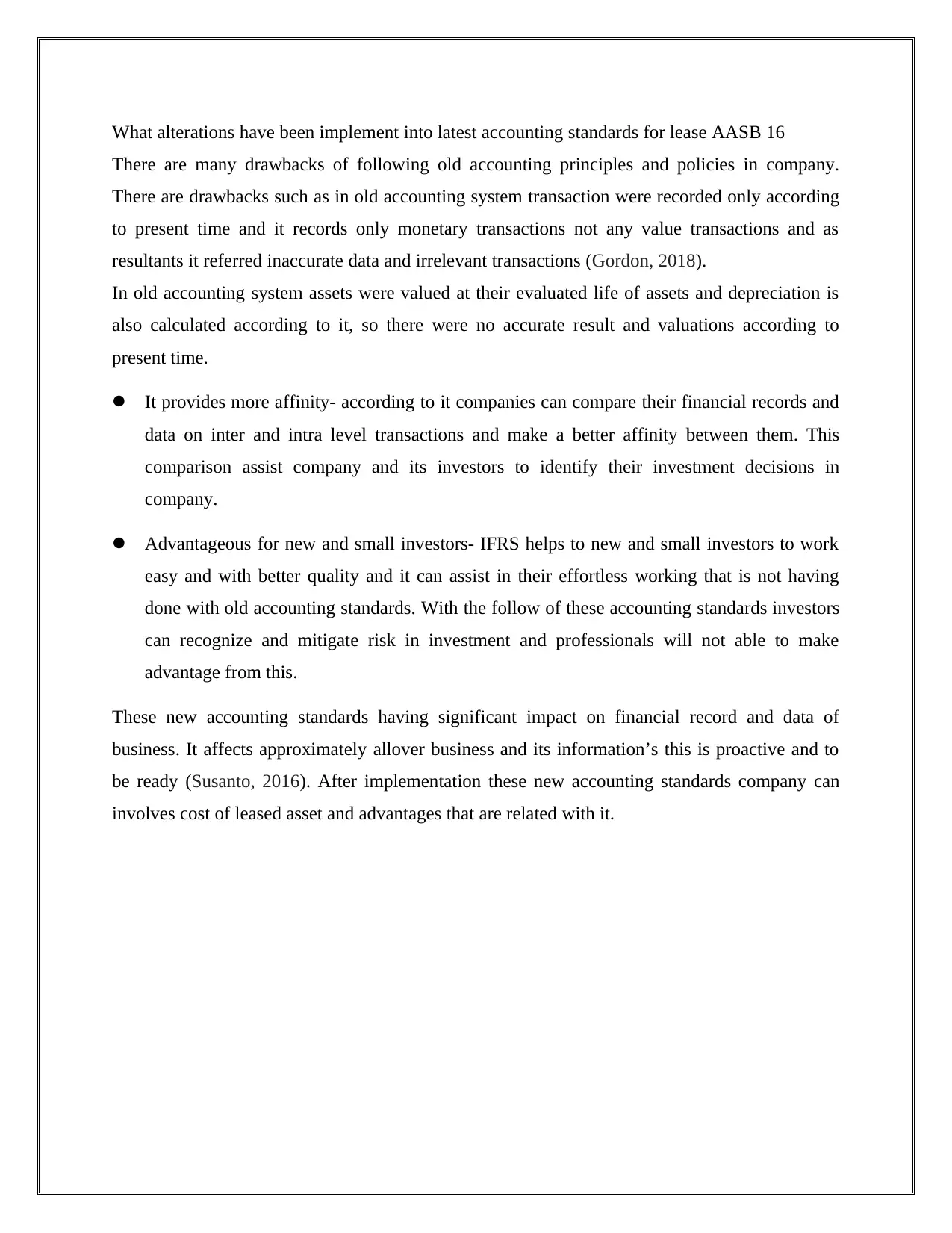
What alterations have been implement into latest accounting standards for lease AASB 16
There are many drawbacks of following old accounting principles and policies in company.
There are drawbacks such as in old accounting system transaction were recorded only according
to present time and it records only monetary transactions not any value transactions and as
resultants it referred inaccurate data and irrelevant transactions (Gordon, 2018).
In old accounting system assets were valued at their evaluated life of assets and depreciation is
also calculated according to it, so there were no accurate result and valuations according to
present time.
It provides more affinity- according to it companies can compare their financial records and
data on inter and intra level transactions and make a better affinity between them. This
comparison assist company and its investors to identify their investment decisions in
company.
Advantageous for new and small investors- IFRS helps to new and small investors to work
easy and with better quality and it can assist in their effortless working that is not having
done with old accounting standards. With the follow of these accounting standards investors
can recognize and mitigate risk in investment and professionals will not able to make
advantage from this.
These new accounting standards having significant impact on financial record and data of
business. It affects approximately allover business and its information’s this is proactive and to
be ready (Susanto, 2016). After implementation these new accounting standards company can
involves cost of leased asset and advantages that are related with it.
There are many drawbacks of following old accounting principles and policies in company.
There are drawbacks such as in old accounting system transaction were recorded only according
to present time and it records only monetary transactions not any value transactions and as
resultants it referred inaccurate data and irrelevant transactions (Gordon, 2018).
In old accounting system assets were valued at their evaluated life of assets and depreciation is
also calculated according to it, so there were no accurate result and valuations according to
present time.
It provides more affinity- according to it companies can compare their financial records and
data on inter and intra level transactions and make a better affinity between them. This
comparison assist company and its investors to identify their investment decisions in
company.
Advantageous for new and small investors- IFRS helps to new and small investors to work
easy and with better quality and it can assist in their effortless working that is not having
done with old accounting standards. With the follow of these accounting standards investors
can recognize and mitigate risk in investment and professionals will not able to make
advantage from this.
These new accounting standards having significant impact on financial record and data of
business. It affects approximately allover business and its information’s this is proactive and to
be ready (Susanto, 2016). After implementation these new accounting standards company can
involves cost of leased asset and advantages that are related with it.
⊘ This is a preview!⊘
Do you want full access?
Subscribe today to unlock all pages.

Trusted by 1+ million students worldwide
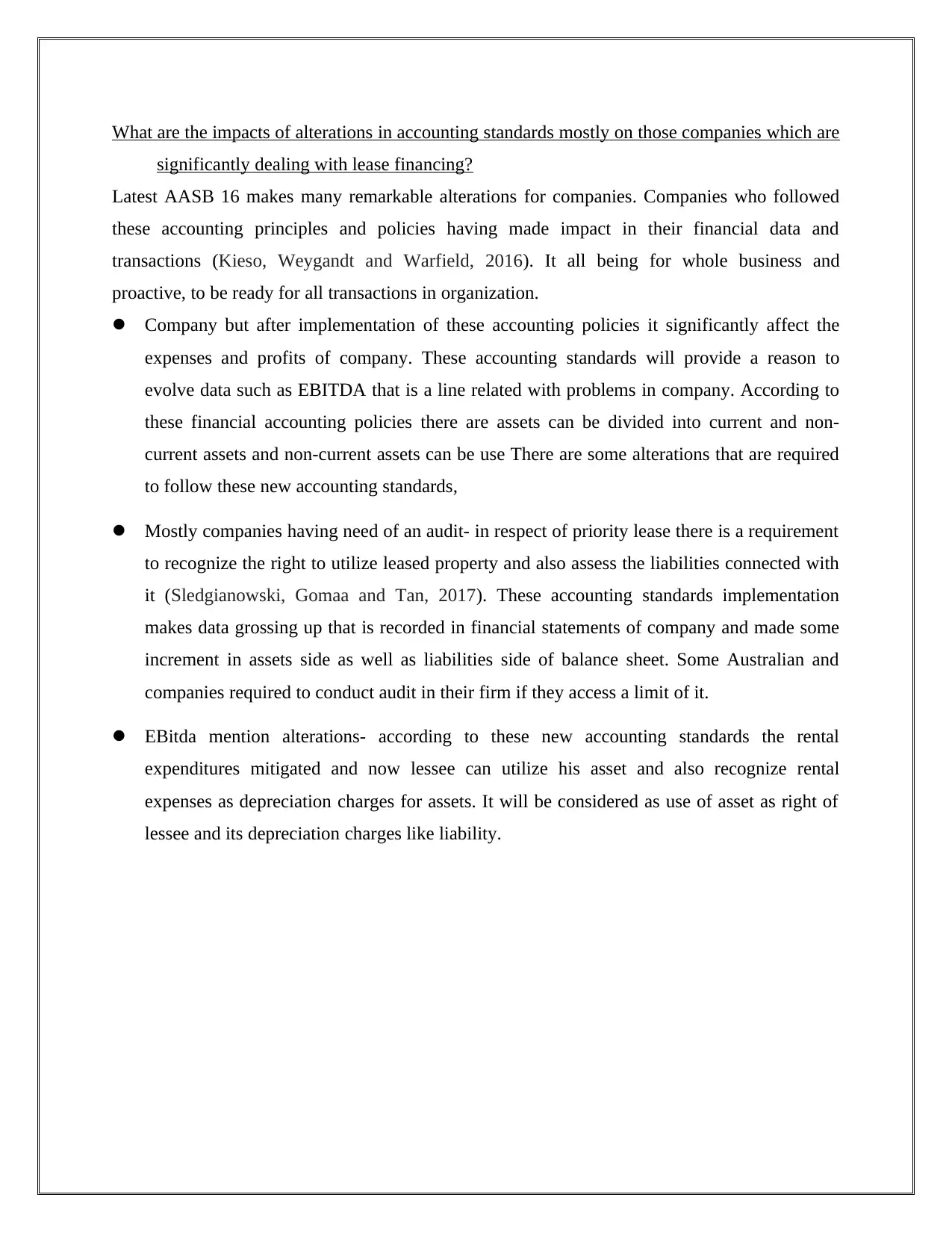
What are the impacts of alterations in accounting standards mostly on those companies which are
significantly dealing with lease financing?
Latest AASB 16 makes many remarkable alterations for companies. Companies who followed
these accounting principles and policies having made impact in their financial data and
transactions (Kieso, Weygandt and Warfield, 2016). It all being for whole business and
proactive, to be ready for all transactions in organization.
Company but after implementation of these accounting policies it significantly affect the
expenses and profits of company. These accounting standards will provide a reason to
evolve data such as EBITDA that is a line related with problems in company. According to
these financial accounting policies there are assets can be divided into current and non-
current assets and non-current assets can be use There are some alterations that are required
to follow these new accounting standards,
Mostly companies having need of an audit- in respect of priority lease there is a requirement
to recognize the right to utilize leased property and also assess the liabilities connected with
it (Sledgianowski, Gomaa and Tan, 2017). These accounting standards implementation
makes data grossing up that is recorded in financial statements of company and made some
increment in assets side as well as liabilities side of balance sheet. Some Australian and
companies required to conduct audit in their firm if they access a limit of it.
EBitda mention alterations- according to these new accounting standards the rental
expenditures mitigated and now lessee can utilize his asset and also recognize rental
expenses as depreciation charges for assets. It will be considered as use of asset as right of
lessee and its depreciation charges like liability.
significantly dealing with lease financing?
Latest AASB 16 makes many remarkable alterations for companies. Companies who followed
these accounting principles and policies having made impact in their financial data and
transactions (Kieso, Weygandt and Warfield, 2016). It all being for whole business and
proactive, to be ready for all transactions in organization.
Company but after implementation of these accounting policies it significantly affect the
expenses and profits of company. These accounting standards will provide a reason to
evolve data such as EBITDA that is a line related with problems in company. According to
these financial accounting policies there are assets can be divided into current and non-
current assets and non-current assets can be use There are some alterations that are required
to follow these new accounting standards,
Mostly companies having need of an audit- in respect of priority lease there is a requirement
to recognize the right to utilize leased property and also assess the liabilities connected with
it (Sledgianowski, Gomaa and Tan, 2017). These accounting standards implementation
makes data grossing up that is recorded in financial statements of company and made some
increment in assets side as well as liabilities side of balance sheet. Some Australian and
companies required to conduct audit in their firm if they access a limit of it.
EBitda mention alterations- according to these new accounting standards the rental
expenditures mitigated and now lessee can utilize his asset and also recognize rental
expenses as depreciation charges for assets. It will be considered as use of asset as right of
lessee and its depreciation charges like liability.
Paraphrase This Document
Need a fresh take? Get an instant paraphrase of this document with our AI Paraphraser
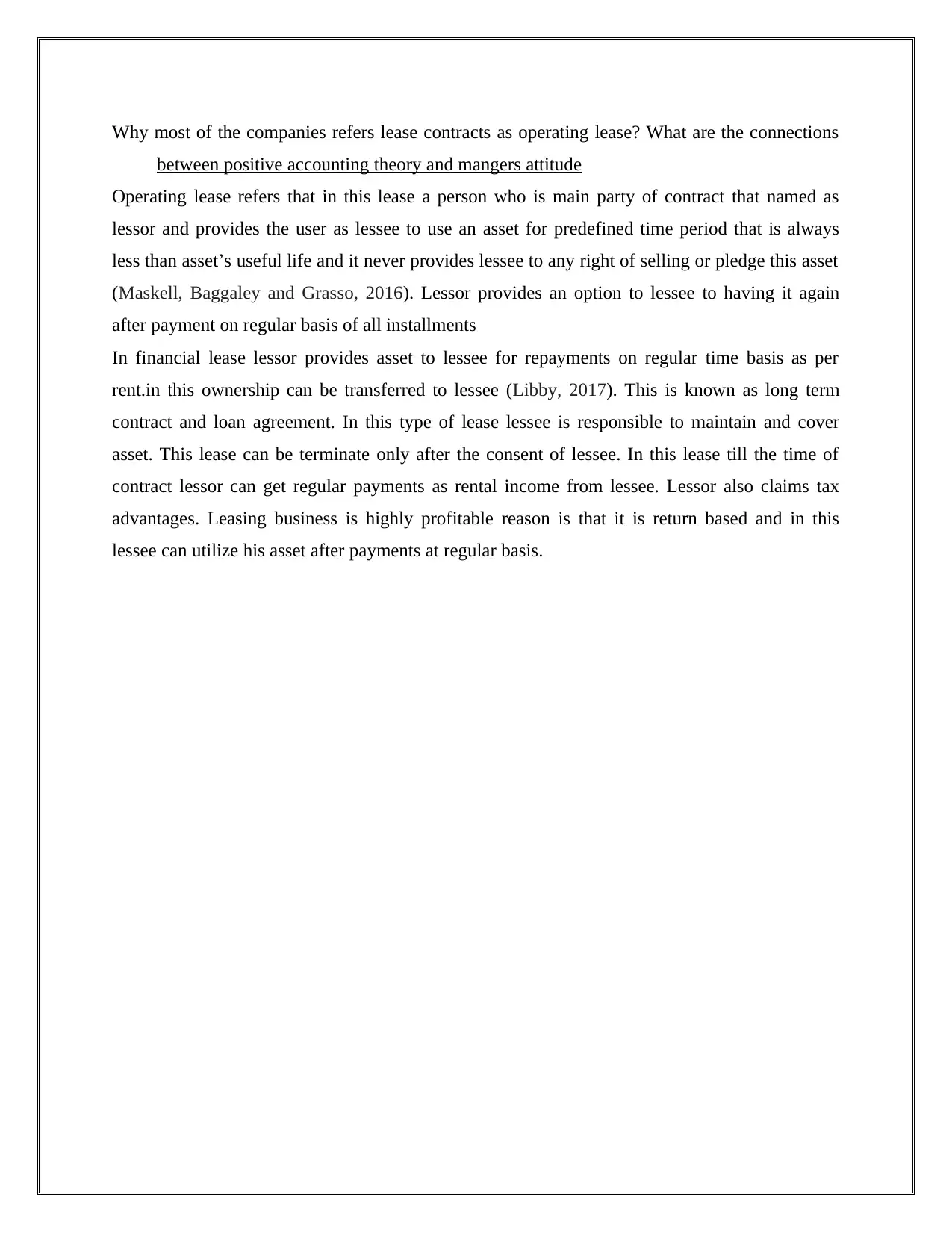
Why most of the companies refers lease contracts as operating lease? What are the connections
between positive accounting theory and mangers attitude
Operating lease refers that in this lease a person who is main party of contract that named as
lessor and provides the user as lessee to use an asset for predefined time period that is always
less than asset’s useful life and it never provides lessee to any right of selling or pledge this asset
(Maskell, Baggaley and Grasso, 2016). Lessor provides an option to lessee to having it again
after payment on regular basis of all installments
In financial lease lessor provides asset to lessee for repayments on regular time basis as per
rent.in this ownership can be transferred to lessee (Libby, 2017). This is known as long term
contract and loan agreement. In this type of lease lessee is responsible to maintain and cover
asset. This lease can be terminate only after the consent of lessee. In this lease till the time of
contract lessor can get regular payments as rental income from lessee. Lessor also claims tax
advantages. Leasing business is highly profitable reason is that it is return based and in this
lessee can utilize his asset after payments at regular basis.
between positive accounting theory and mangers attitude
Operating lease refers that in this lease a person who is main party of contract that named as
lessor and provides the user as lessee to use an asset for predefined time period that is always
less than asset’s useful life and it never provides lessee to any right of selling or pledge this asset
(Maskell, Baggaley and Grasso, 2016). Lessor provides an option to lessee to having it again
after payment on regular basis of all installments
In financial lease lessor provides asset to lessee for repayments on regular time basis as per
rent.in this ownership can be transferred to lessee (Libby, 2017). This is known as long term
contract and loan agreement. In this type of lease lessee is responsible to maintain and cover
asset. This lease can be terminate only after the consent of lessee. In this lease till the time of
contract lessor can get regular payments as rental income from lessee. Lessor also claims tax
advantages. Leasing business is highly profitable reason is that it is return based and in this
lessee can utilize his asset after payments at regular basis.
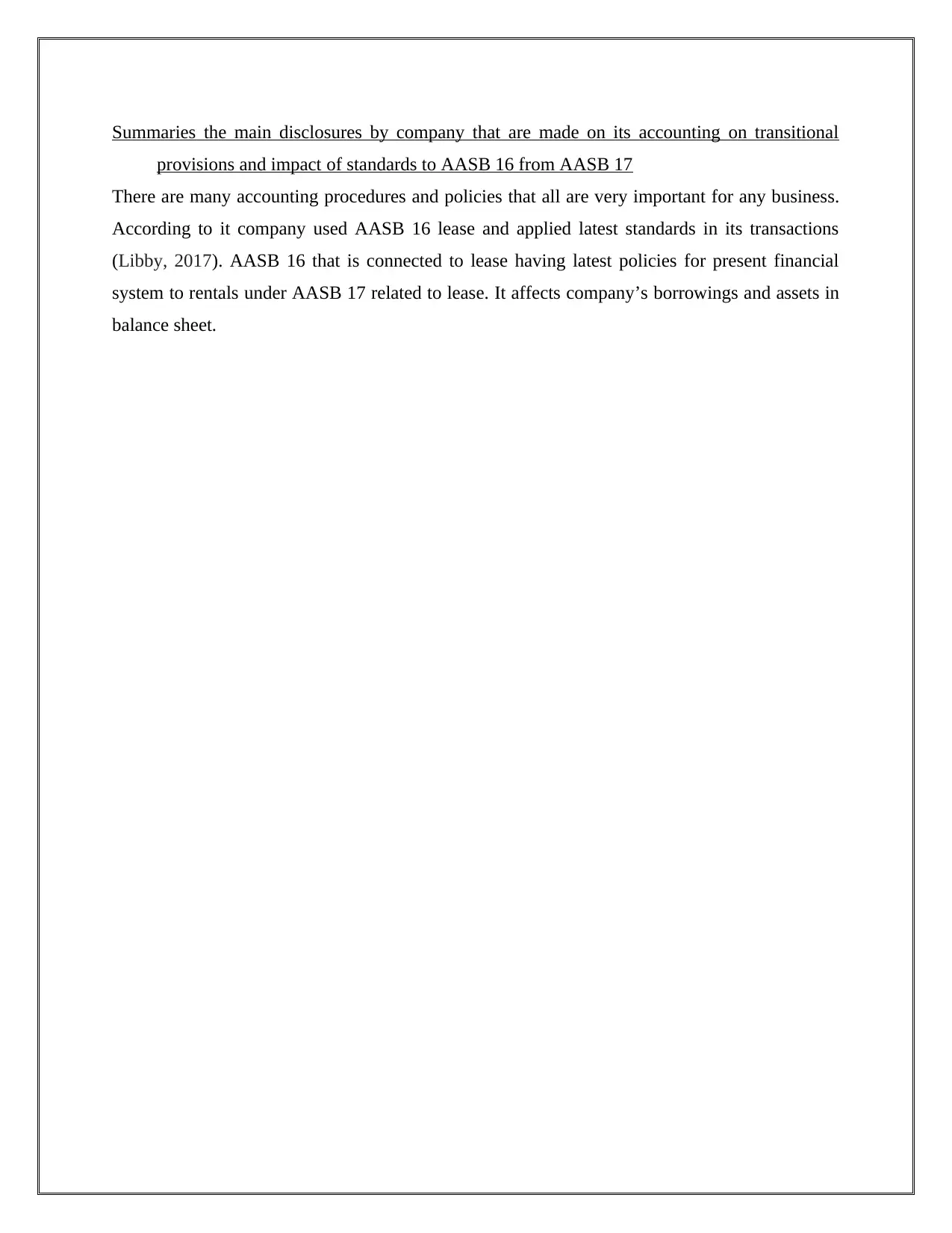
Summaries the main disclosures by company that are made on its accounting on transitional
provisions and impact of standards to AASB 16 from AASB 17
There are many accounting procedures and policies that all are very important for any business.
According to it company used AASB 16 lease and applied latest standards in its transactions
(Libby, 2017). AASB 16 that is connected to lease having latest policies for present financial
system to rentals under AASB 17 related to lease. It affects company’s borrowings and assets in
balance sheet.
provisions and impact of standards to AASB 16 from AASB 17
There are many accounting procedures and policies that all are very important for any business.
According to it company used AASB 16 lease and applied latest standards in its transactions
(Libby, 2017). AASB 16 that is connected to lease having latest policies for present financial
system to rentals under AASB 17 related to lease. It affects company’s borrowings and assets in
balance sheet.
⊘ This is a preview!⊘
Do you want full access?
Subscribe today to unlock all pages.

Trusted by 1+ million students worldwide
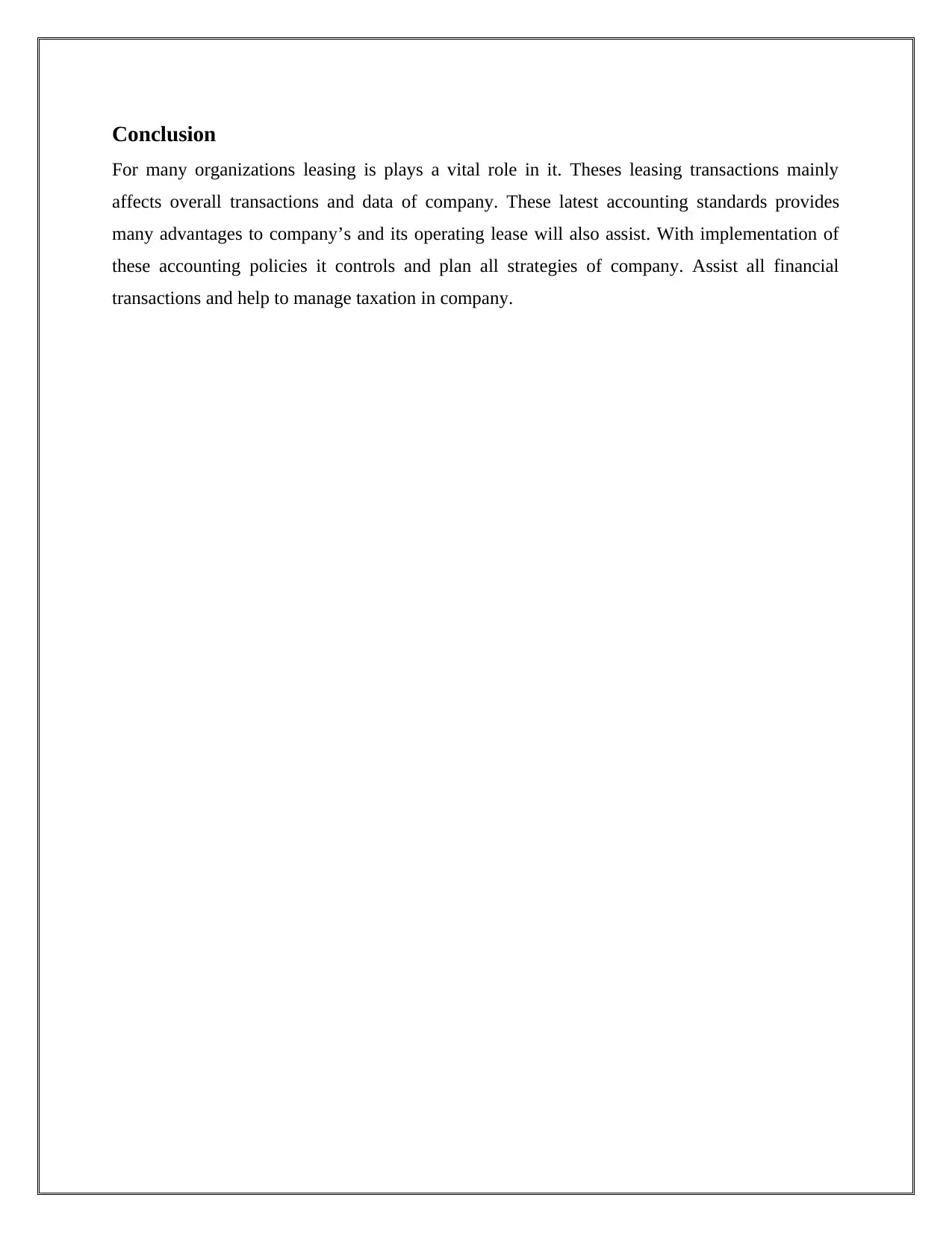
Conclusion
For many organizations leasing is plays a vital role in it. Theses leasing transactions mainly
affects overall transactions and data of company. These latest accounting standards provides
many advantages to company’s and its operating lease will also assist. With implementation of
these accounting policies it controls and plan all strategies of company. Assist all financial
transactions and help to manage taxation in company.
For many organizations leasing is plays a vital role in it. Theses leasing transactions mainly
affects overall transactions and data of company. These latest accounting standards provides
many advantages to company’s and its operating lease will also assist. With implementation of
these accounting policies it controls and plan all strategies of company. Assist all financial
transactions and help to manage taxation in company.
Paraphrase This Document
Need a fresh take? Get an instant paraphrase of this document with our AI Paraphraser
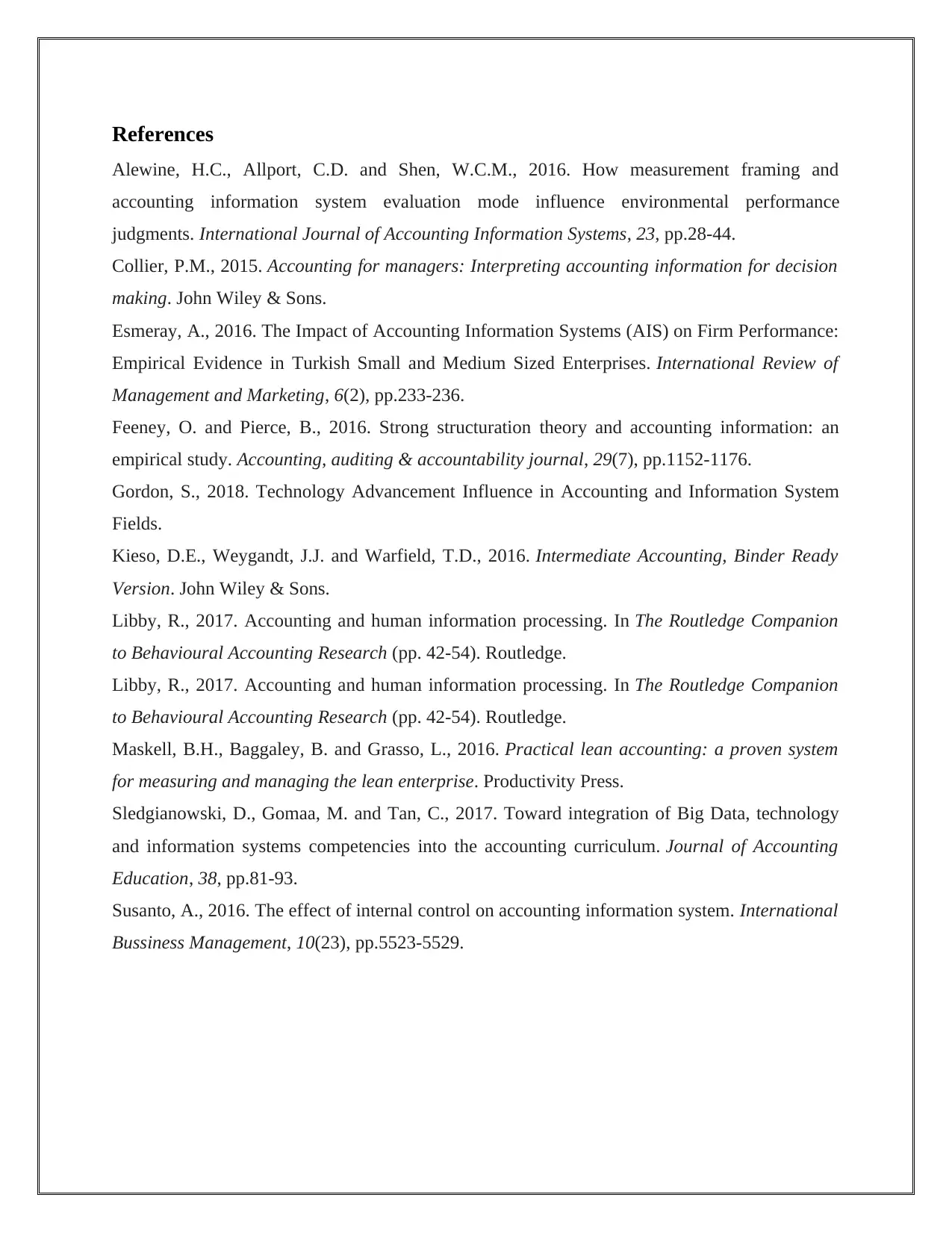
References
Alewine, H.C., Allport, C.D. and Shen, W.C.M., 2016. How measurement framing and
accounting information system evaluation mode influence environmental performance
judgments. International Journal of Accounting Information Systems, 23, pp.28-44.
Collier, P.M., 2015. Accounting for managers: Interpreting accounting information for decision
making. John Wiley & Sons.
Esmeray, A., 2016. The Impact of Accounting Information Systems (AIS) on Firm Performance:
Empirical Evidence in Turkish Small and Medium Sized Enterprises. International Review of
Management and Marketing, 6(2), pp.233-236.
Feeney, O. and Pierce, B., 2016. Strong structuration theory and accounting information: an
empirical study. Accounting, auditing & accountability journal, 29(7), pp.1152-1176.
Gordon, S., 2018. Technology Advancement Influence in Accounting and Information System
Fields.
Kieso, D.E., Weygandt, J.J. and Warfield, T.D., 2016. Intermediate Accounting, Binder Ready
Version. John Wiley & Sons.
Libby, R., 2017. Accounting and human information processing. In The Routledge Companion
to Behavioural Accounting Research (pp. 42-54). Routledge.
Libby, R., 2017. Accounting and human information processing. In The Routledge Companion
to Behavioural Accounting Research (pp. 42-54). Routledge.
Maskell, B.H., Baggaley, B. and Grasso, L., 2016. Practical lean accounting: a proven system
for measuring and managing the lean enterprise. Productivity Press.
Sledgianowski, D., Gomaa, M. and Tan, C., 2017. Toward integration of Big Data, technology
and information systems competencies into the accounting curriculum. Journal of Accounting
Education, 38, pp.81-93.
Susanto, A., 2016. The effect of internal control on accounting information system. International
Bussiness Management, 10(23), pp.5523-5529.
Alewine, H.C., Allport, C.D. and Shen, W.C.M., 2016. How measurement framing and
accounting information system evaluation mode influence environmental performance
judgments. International Journal of Accounting Information Systems, 23, pp.28-44.
Collier, P.M., 2015. Accounting for managers: Interpreting accounting information for decision
making. John Wiley & Sons.
Esmeray, A., 2016. The Impact of Accounting Information Systems (AIS) on Firm Performance:
Empirical Evidence in Turkish Small and Medium Sized Enterprises. International Review of
Management and Marketing, 6(2), pp.233-236.
Feeney, O. and Pierce, B., 2016. Strong structuration theory and accounting information: an
empirical study. Accounting, auditing & accountability journal, 29(7), pp.1152-1176.
Gordon, S., 2018. Technology Advancement Influence in Accounting and Information System
Fields.
Kieso, D.E., Weygandt, J.J. and Warfield, T.D., 2016. Intermediate Accounting, Binder Ready
Version. John Wiley & Sons.
Libby, R., 2017. Accounting and human information processing. In The Routledge Companion
to Behavioural Accounting Research (pp. 42-54). Routledge.
Libby, R., 2017. Accounting and human information processing. In The Routledge Companion
to Behavioural Accounting Research (pp. 42-54). Routledge.
Maskell, B.H., Baggaley, B. and Grasso, L., 2016. Practical lean accounting: a proven system
for measuring and managing the lean enterprise. Productivity Press.
Sledgianowski, D., Gomaa, M. and Tan, C., 2017. Toward integration of Big Data, technology
and information systems competencies into the accounting curriculum. Journal of Accounting
Education, 38, pp.81-93.
Susanto, A., 2016. The effect of internal control on accounting information system. International
Bussiness Management, 10(23), pp.5523-5529.
1 out of 11
Related Documents
Your All-in-One AI-Powered Toolkit for Academic Success.
+13062052269
info@desklib.com
Available 24*7 on WhatsApp / Email
![[object Object]](/_next/static/media/star-bottom.7253800d.svg)
Unlock your academic potential
Copyright © 2020–2025 A2Z Services. All Rights Reserved. Developed and managed by ZUCOL.





